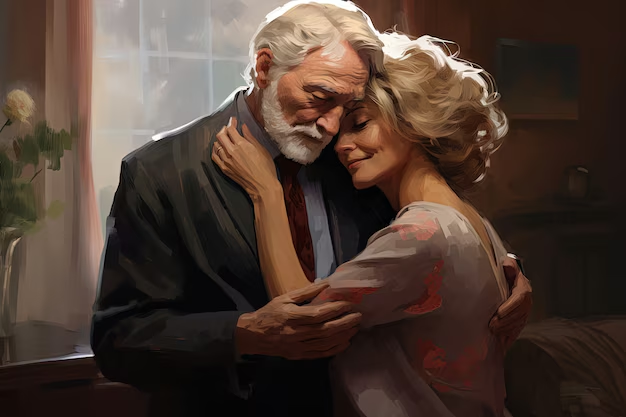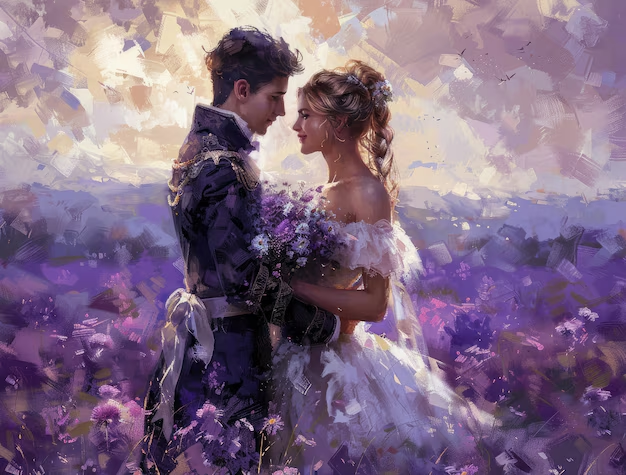Top 5 Most Famous Romantic Paintings: Exploring Love & Desire
Have you ever stood before a painting and felt a surge of emotion, a whisper of love, or a pang of longing? Romantic paintings have a unique ability to stir our souls, to transport us to a world where passion reigns supreme. In this article, we’ll explore five breathtaking artworks that perfectly capture love and passion, diving into their history, styles, and the stories they tell. Get ready to discover famous romantic paintings and their stories! #LoveInArt
Table of Contents
Discover the Heart of Romanticism in Art

Romanticism, as an artistic and intellectual movement, swept across Europe and America in the late 18th and early 19th centuries. It was a rebellion against the Enlightenment’s emphasis on reason and order, embracing instead emotion, imagination, and the beauty of the natural world. Romantic paintings, therefore, became a powerful medium for expressing intense feelings, from the thrill of first love to the depths of despair.
So, what makes a painting “romantic”? It’s not just about depicting couples holding hands. It’s about capturing the sublime, the awe-inspiring, and the overwhelming power of human emotion. It’s about celebrating individuality, freedom, and the raw, untamed aspects of life.
The Top 5 Romantic Paintings That Will Stir Your Soul
Let’s embark on a journey through some of the most iconic and emotionally charged romantic paintings ever created. Prepare to be captivated by their beauty, moved by their stories, and inspired by their passionate spirit.
1. The Kiss by Gustav Klimt (1907-1908)
Perhaps the most iconic representation of romantic love in art, The Kiss is a masterpiece of the Art Nouveau and Symbolist movements. Its shimmering gold leaf and intricate patterns create an otherworldly atmosphere, enveloping the embracing couple in a cocoon of intimacy.
- Key Points: Gold leaf, symbolism, intimacy, Art Nouveau.
- Story: The painting depicts a couple locked in a passionate embrace, their bodies intertwined and adorned with symbolic patterns. The gold leaf background creates a sense of timelessness and otherworldly beauty. The identity of the models is unknown, but it is rumored that Klimt himself and his muse, Emilie Flöge, were the inspiration.
Why It Resonates
The Kiss speaks to our universal desire for connection, for finding solace and joy in the arms of another. Its opulent beauty and intimate portrayal of love continue to captivate viewers around the world.
2. The Starry Night by Vincent van Gogh (1889)
While not explicitly a depiction of romantic love, The Starry Night embodies the Romantic spirit through its intense emotional expression and awe-inspiring portrayal of nature. Painted during Van Gogh’s stay at an asylum in Saint-Rémy, it reflects his inner turmoil and his profound connection to the cosmos.
- Key Points: Expressionism, emotional intensity, nature, impasto technique.
- Story: Van Gogh painted The Starry Night from the window of his asylum room. The swirling brushstrokes and vibrant colors convey a sense of energy and movement, while the towering cypress tree reaches towards the heavens, symbolizing hope and connection. The painting is a testament to Van Gogh’s ability to find beauty and meaning even in the midst of suffering.
Romanticism in the Stars
The painting reflects the Romantic ideal of finding the sublime in nature and expressing personal emotions through art. It’s a powerful reminder of the human capacity for feeling and the beauty that can be found even in the darkest of times.
3. Wanderer Above the Sea of Fog by Caspar David Friedrich (1818)

This iconic painting perfectly encapsulates the Romantic concept of the sublime. A lone figure stands on a rocky precipice, gazing out at a vast expanse of fog-covered mountains. The painting evokes a sense of awe, mystery, and the insignificance of humanity in the face of nature’s grandeur.
- Key Points: The Sublime, nature, introspection, German Romanticism.
- Story: The wanderer, dressed in a dark coat, is believed to be Friedrich himself. The painting is not just a landscape; it’s a meditation on the relationship between the individual and the natural world. The fog represents the unknown, while the mountains symbolize the challenges and triumphs of life.
Finding Yourself in the Vastness
While not a traditional love story, Wanderer Above the Sea of Fog speaks to the Romantic yearning for something beyond the mundane, a desire to connect with the infinite and discover one’s place in the universe.
4. Psyche Revived by Cupid’s Kiss by Antonio Canova (1787-1793)
While technically a sculpture, this masterpiece deserves inclusion for its stunning portrayal of romantic love and its profound impact on the Romantic era. The sculpture depicts the moment Cupid awakens Psyche with a kiss, bringing her back to life.
- Key Points: Neoclassical, mythology, love, resurrection.
- Story: Based on the myth of Cupid and Psyche, the sculpture captures the transformative power of love. Psyche, having fallen into a deathlike sleep, is brought back to life by Cupid’s tender kiss. The sculpture’s delicate details and graceful lines convey a sense of ethereal beauty and profound emotion.
The Power of a Kiss
Psyche Revived by Cupid’s Kiss is a celebration of love’s ability to conquer death and transform lives. Its timeless beauty and emotional power continue to inspire awe and wonder.
5. The Raft of the Medusa by Théodore Géricault (1818-1819)
This monumental painting depicts the aftermath of a real-life shipwreck, where survivors were left adrift on a makeshift raft. While seemingly a scene of despair and suffering, it embodies the Romantic spirit through its dramatic intensity and its focus on human emotion in the face of adversity.
- Key Points: French Romanticism, realism, tragedy, human suffering.
- Story: Géricault meticulously researched the event, interviewing survivors and studying corpses to ensure the accuracy of his portrayal. The painting is a powerful indictment of the French government’s incompetence and a testament to the resilience of the human spirit.
Love and Loss in the Face of Disaster
The romantic elements are evident in the extreme drama and raw emotions displayed. Love for fellow man, hope amidst despair, and the fierce will to survive – all cornerstones of romanticism – are on full display. It is a reminder of the fragility of life and the importance of human connection in the face of tragedy.
How Romantic Paintings Reflect Love & Relationships

Romantic paintings offer profound insights into the complexities of love and relationships. They explore a wide range of emotions, from the joy of connection to the pain of loss, reflecting the human experience in all its messy glory.
| Theme | Reflection in Romantic Paintings |
| Idealized Love | Paintings often depict idealized versions of love, emphasizing beauty, passion, and spiritual connection. |
| Emotional Intensity | Romantic paintings capture the full spectrum of human emotions, from joy and ecstasy to sorrow and despair. |
| Individuality | The movement celebrates individuality and self-expression, reflecting the importance of personal feelings in relationships. |
| Nature as a Metaphor | Nature is often used as a metaphor for love and relationships, with landscapes reflecting the emotional states of the characters. |
| The Sublime | Romantic paintings explore the sublime, the awe-inspiring and overwhelming power of love and nature. |
FAQ: Exploring Romantic Paintings
Do you have more questions about romantic paintings? Let’s delve into some frequently asked questions.
What defines a painting as “romantic“?
A romantic painting typically emphasizes emotion, imagination, and the beauty of the natural world. It often depicts scenes of love, passion, or longing, and it may also explore themes of individuality, freedom, and the sublime.
Who were some of the key artists of the Romantic movement?
Key artists of the Romantic movement include Caspar David Friedrich, Eugène Delacroix, J.M.W. Turner, and Francisco Goya.
Where can I see romantic paintings in person?
Many major museums around the world have collections of Romantic paintings. Some notable museums include the Louvre in Paris, the Metropolitan Museum of Art in New York, and the National Gallery in London.
How did the Romantic movement influence art and culture?
The Romantic movement had a profound impact on art, literature, music, and philosophy. It shifted the focus from reason to emotion, celebrating individuality, imagination, and the power of the human spirit.
Conclusion: The Enduring Power of Romantic Paintings
From the intimate embrace of Klimt’s The Kiss to the awe-inspiring vastness of Friedrich’s Wanderer Above the Sea of Fog, romantic paintings continue to captivate and inspire us. They offer a glimpse into the depths of human emotion, reminding us of the power of love, the beauty of nature, and the enduring strength of the human spirit.
We hope you’ve enjoyed this exploration of the top 5 romantic paintings. Which of these artworks resonated with you the most? Share your thoughts and feelings in the comments below! And don’t forget to share this article with your friends who appreciate the beauty and passion of art. Explore more resources on romanticism to dive deeper into this

